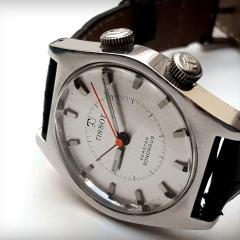Help with movement Otero 256
-
Recently Browsing
- No registered users viewing this page.
-
Topics
-
Posts
-
My understanding is that In the Etachron system the spring is only centered n order to set the stud angle when the the pins are wide open and the regulator block in at the midway point. After that the pins are rotated in one direction only so that the width between the spring and one of the studs is 1/2 width of the spring. This results in the spring always being closer to one stud than other one.
-
The idea is that the spring is centred between the pins when at rest. Then when the watch is running it will oscillate equally between the pins i.e. bounce off one pin then the other, as the hairspring breathes. If the spring is only hitting one pin, then it isn't centred, and most likely the pins are too far apart. Yes, the regulator pins are there to adjust the effective length of the hairspring. The spacing of the regulator pins should not affect the amplitude. The vertical positions typically have lower amplitude than the horizontal ones. This has nothing to with the regulator - hairspring interaction. Increased friction in the verticals sucks energy from the system and reduces the amplitude. If the amplitude is less, the breathing is less. More tim between the pins = more effective length. Depending on how well the hairspring is centred, and which direction it sags, some vertical positions might run faster than the horizontal ones, and others slower. For example, if the spring is off centre towards on pin, and pressed against it by gravity, it might never bounce off that pin => faster. At the position 180 deg. away, the spring will spend more time in between the pins => slower.
-
By coreymsnow · Posted
Thank you all for the tips and insights. I'm looking carefully at the Sherline lathes with a milling attachment. I need to figure out exactly what I'd need to get in terms of the base lathe and attachments to be able to fabricate basic parts and learn how to fabricate some of the less basic ones- like a cannon pinion. Thank you again. -
Welkom Sebastiaan! Veel plezier met deze hobby!
-





Recommended Posts